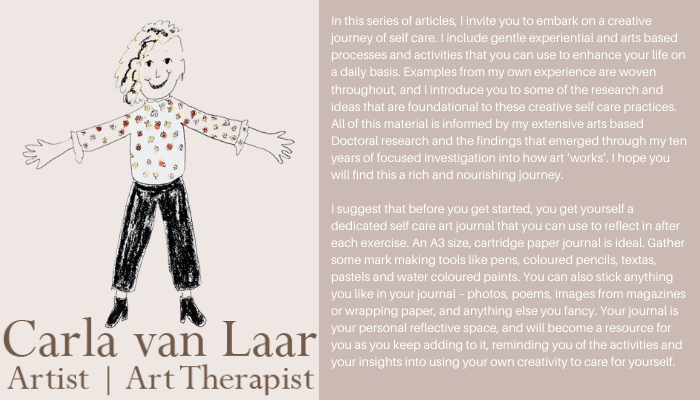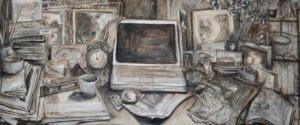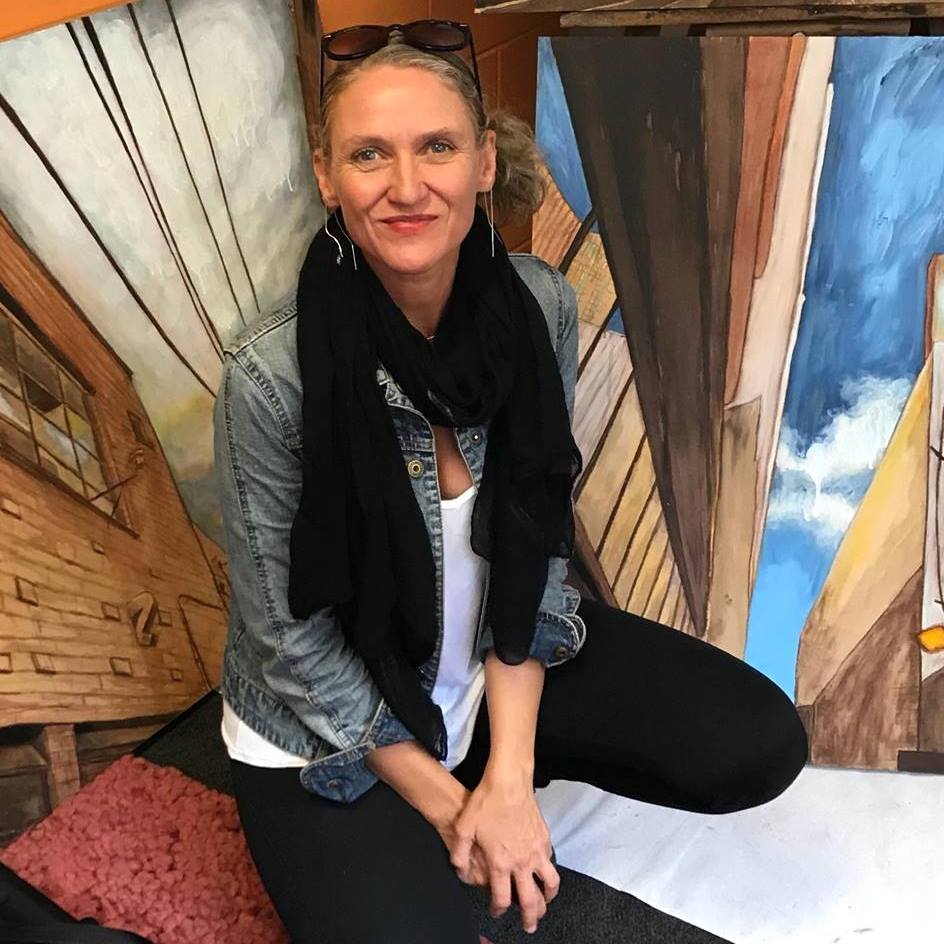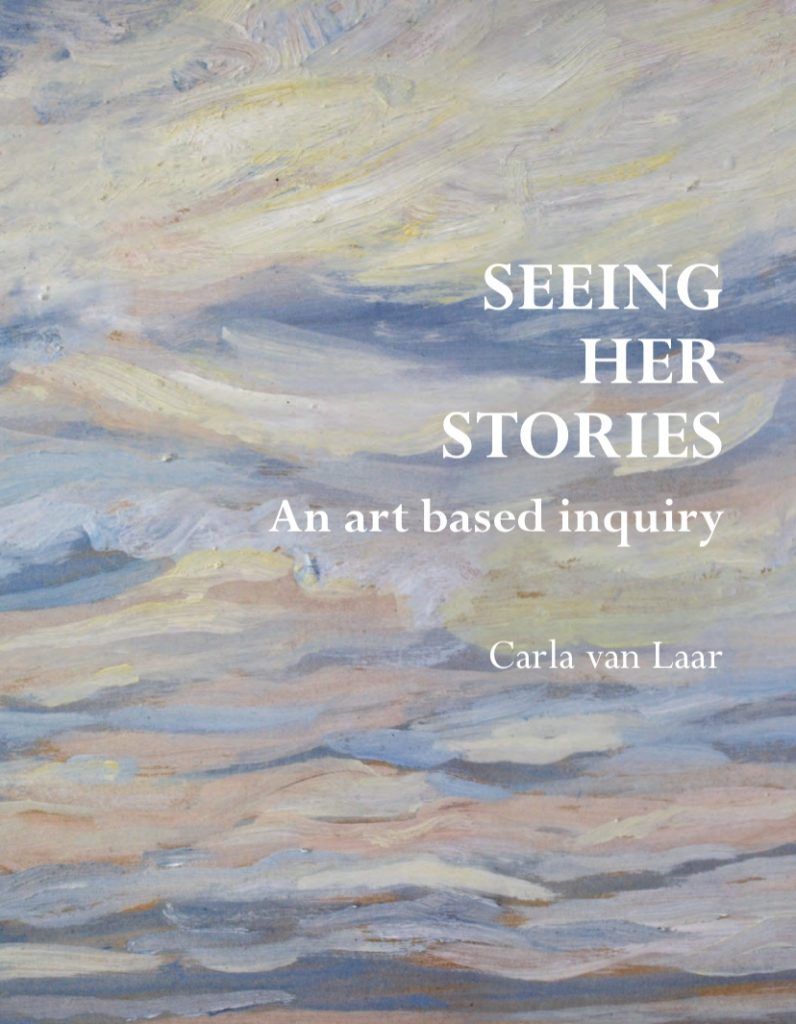With Dr Carla van Laar AThR
Feature image credit Carla van Laar
In this article I share some of my findings about how art can facilitate feelings of deep connection, I then invite you to find an artwork that reaches out to you, and to make an art work in response.

Seeing other people’s artworks as a connecting experience
As part of my Doctoral research, I investigated what happens when we view artworks. What I found was that seeing artworks made by other people can be a profoundly connecting experience. I write about my findings in this extract:
“…responses from the participants reveal how they had their own experiences of feeling connected to and in relationship with my artworks. I start with an extract from the dinner party, where I read out loud Freya’s words from a letter she wrote to me.
“This is Aunty Freya, and she’s talking about this painting here”, I say and gesture upward above my head where the picture of my cluttered desk hangs above me on the wall.

Then I read Freya’s words:
“This picture offers insights across time and space, in a way similar to how a portrait of an ancestor offers a little insight to the person they may have been.
It reminds me of my life, and makes me wonder how much nature and how much nurture influences parallel parts of our existence, yours and mine. At times our lives have intersected and we have known and loved the same people, yet there is also much that we do not know about each other.
Perhaps some of my questions are answered in this painting. I can subjectively interpret some symbolism in every object, and it leads me to wonder if they have similar meanings for you.
I feel comforted by clutter that gives me a sense that my life is meaningful and busy. For me, objects tend to be heavily imbued with nostalgia and emotion, even though my mother used to say, ‘They’re only objects, people are more important’.
Often my urgent things get mislaid amongst important things. You have the urgent paper sitting right there on top of the others.
I wonder, in years to come, if other, younger, family members will look at this painting and identify with the people and objects and create some meaningful connection across the generations, perhaps recognizing parts of their own personality in the representations.”
As illustrated in my story of reading Freya’s words at the dinner party, the intersubjective threads of relationship, connection and co-creation were inextricably woven together within the lived complexity of seeing her stories encounters.
Freya’s words help me to wonder in awe yet again at the power of art in evoking matters of meaning and significance. Freya’s complex relating to my painting includes the evocation of her own meaning making processes, then her self-aware wondering about my meanings, the similarities and divergences in our meaning making, the intergenerational nature of these, and the potential for future generations to connect with both of us through her imagining of them also seeing my stories through art. Freya’s words paint her own picture of connection through seeing stories as an unfolding, evolving, dynamic creative process of life, family and identity.
Here is how Julie expressed her experience of seeing the portrait of herself being painted co-creatively and how that supported her relationship with her own creative journey as a woman.
“The symbol of it went to the very core of my soul. I felt this incredible, deep… humbling and deep connection with all women on this planet, who have been on ‘the road’, whether an actual road or a metaphoric road. It was immensely powerful for me, and incredibly enlightening, in my own journey and the creating of each other through this process. I feel like I’ve been supported in creating my thinking about women’s journey on the road, and the creation of the portrait has furthered that and deepened that. And personalised that for me.
Suffice to say, the metaphor of the road for me, is a central part of my involvement in this project. And women’s paths.”
Nicola talks about the artworks themselves as though they can be a metaphoric invitational meeting place between the artist and the viewer. In Nicola’s description, the experience of seeing her stories is co-creative by nature.
“We’ve had lots of discussions, throughout this project, about creating art, and creating space in the art that anyone can climb into and have their own experience. About how you have it personal enough so that they can connect with it, but de-personalise it enough so that they can project their own experiences onto it. And a great artist will always try and play with that, they’ve played with it for centuries. But I feel like Carla’s works are archetypal in that way, you can really climb into them, as well as them climbing out to you. That’s a real gift, to do that in a way that’s not too literal, that still has all the symbols, but you’re not pulling away because it’s a cliché, you are actually invited into it, because there’s that universality, and it is still unique. That’s what the art is. I find that your works do that.”
These three examples are connected through the theme of feeling connected with more than just one’s own personal life history through the seeing of the artwork. Freya talks about intergenerational connectedness, Julie talks about her relationship with women’s collective journeys and how these were personalised for her by the portrait of her sitting on the road, and Nicola expresses feeling invited into connection with archetypal and universal themes with which she has her own personal relationship. The sense of feeling that their own life experiences were connected with others through their seeing of my stories was important to these three women, and illustrates how seeing artworks can affirm a viewer’s lived experience, providing companionship on the journey, and inspiring a sense that life is meaningful.”
(van Laar 2020)
Finding an Artwork that speaks to you, and making a Response
In this activity, I invite you to find an artwork that reaches out to you, that speaks to you, that captures your interest or imagination, or that resonates with you in some way.
You might decide to visit a gallery or museum – actually go out to one, or visit one online.
You might decide to look through some art books until something catches your eye.
You might just go for a walk and come across something in a shop window or on a street wall.
You will know when you have found an artwork to respond to, because you will feel affected by it.
When you find something, stay with it for some time, maybe up to half an hour. You might like to journal while you are spending time with it. Here are some prompts for your journal:
You can talk to the art work directly, and ask it questions, for example:
- What are you made of?
- Who made you?
- What was the process of making, what efforts were required to make you?
- What message do you have for me today?
When you return home, I would like to invite you to make an artwork in response.
You can use absolutely anything you like.
Paper, paint, found objects, digital media, poetry, film, sound, music, movement, anything!
Simply imagine that art is a way of having a conversation, and in making your own artwork you are having a conversation with the artwork that you found today.
When you are finished, you can ask yourself some questions in your journal.
Questions for reflective journaling
Again, speak directly to your artwork and ask it questions. Write down the answers you receive.
- What are you made of?
- Who made you?
- What was the process of making, what efforts were required to make you?
- What message do you have for me today?
…
References
van Laar, C. Seeing Her Stories. Carlavanlaar.com, Brunswick, Australia.

Dr Carla van Laar
Artist | Art Therapist
Master of Creative Arts Therapy
Doctor of Therapeutic Arts Practice
Registered Supervisor and Professional Member ANZACATA
Carla van Laar is a painter and therapeutic arts practitioner from Australia. Born in Brisbane, Carla is first generation Australian on her Dutch grandparents side, and 7th generation through her maternal bloodline who were mostly English and came to Australia in the early colonisation of the 1800s. Carla currently lives and works in Victoria, residing between Wurrundjeri country in Melbourne, and Boon Wurrung country in Inverloch, paying deep respects to the First Peoples of the Kulin Nations whose land was never ceded and will always be Aboriginal land. Identifying as a cisgender woman, Carla is passionately disinterested in socially constructed identities that disempower anyone. Carla has over 25 years’ experience working with people and the arts for health and well-being in community organisations, justice, health and education contexts.
Carla’s first book “Bereaved Mother’s Heart” was published in 2007 and broke social taboos about maternal grief. From 2008-18 she established and ran an independent art therapy studio and gallery in Melbourne. Her Doctoral research “Seeing Her Stories” continues the mission to make women’s stories visible, through art.
Carla has lectured and supervised Art Therapy students at RMIT, MIECAT and currently the IKON Institute. She is a practicing artist and in 2018 received an Artist Fellowship at RMIT’s creative research lab, “Creative Agency”. She insists on being part of a creative revolution in which art re-embodies lived experience, brings us to our senses, makes us aware of the interconnectedness of all life and is an agent of social change.
Carla’s new book “Seeing her stories” presents her research into making unseen stories visible through art, and is available to read for free online here or purchase a hard copy of the full colour hard cover coffee table book here.



Leave a Reply